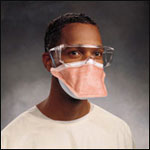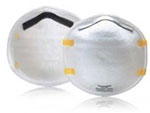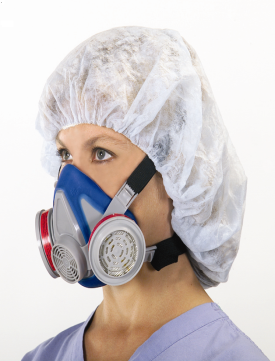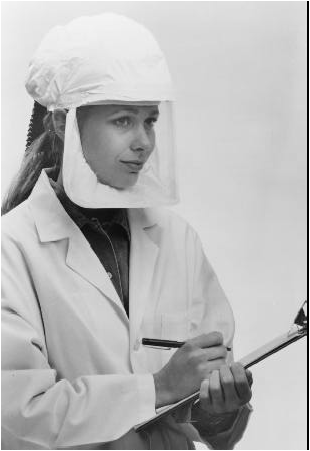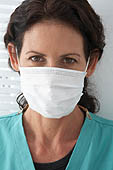5 Antineoplastic Agents (Administer)
Survey of Healthcare Workers' Health and Safety Practices
Attachment I4_Module C_FINAL_8042010
Secondary Hazard Module
OMB: 0920-0860
MODULE C: Antineoplastic Agents (Administer) Form Approved
7/23/10 OMB No. 10AP-xxxx
Expiration Date: xx/xx/2011
PROGRAMMING INSTRUCTIONS APPEAR IN BLUE.
|
||||
|
|
During your career, how long have you been administering antineoplastic agents to patients?
|
|
|
|
|
||||
|
|
What training, if any, have you received on the safe handling of antineoplastic agents?
Please all that apply. |
|
GO to Question 4
|
|
|
||||
|
|
When was the last time you received training on the safe handling of antineoplastic agents?
|
|
|
|
|
|
How familiar are you with the following guidance documents on the safe handling of antineoplastic agents? |
Very |
Somewhat |
Not at All |
|
a. American Society of Health-System Pharmacists (ASHP) guidelines for handling hazardous drugs |
¦ |
¦ |
¦ |
||
b. NIOSH Alert on Preventing Exposures to Antineoplastic Agents and Other Hazardous Drugs |
¦ |
¦ |
¦ |
||
c. Oncology Nurses Society (ONS) Safe Handling of Hazardous Drugs |
¦ |
¦ |
¦ |
||
d. Occupational Safety and Health Administration (OSHA) guidelines for the management of antineoplastic drugs |
¦ |
¦ |
¦ |
||
If you work for more than one employer, the following questions apply to your primary employer, i.e., the one for which you typically work the most hours. If you are self-employed, consider yourself the employer. |
|||||
|
|
Does your employer have procedures that address safe administration of antineoplastic agents? |
|
|
||
|
|||||
Questions addressing work practices and use of personal protective clothing and equipment will help us understand what is currently used and under what circumstances. Depending on your job and exposures, these may not be required.
skip questions 15 a, b, c and d, if ‘100%’ tablets/capsules in question 10b. |
|||||||||||||||
|
|
During the past 7 calendar days while administering antineoplastic agents to patients, how often did you…
|
Always
|
Sometimes
|
Never
|
|||||||||||
a. …use a closed-system transfer device (e.g., PhaSeal)? |
¦ |
¦ |
¦ |
||||||||||||
b. …use Luer-Lock fittings for all needleless systems, syringes, needles, infusion tubing, and pumps? |
¦ |
¦ |
¦ |
||||||||||||
c. …use a needle-less system? |
¦ |
¦ |
¦ |
||||||||||||
d. …use a plastic-backed absorbent pad under injection site? |
¦ |
¦ |
¦ |
||||||||||||
e. …replace gloves immediately when damaged or contaminated? |
¦ |
¦ |
¦ |
||||||||||||
f. …wash hands after removing gloves? |
¦ |
¦ |
¦ |
||||||||||||
g. …wear shoe covers? |
¦ |
¦ |
¦ |
||||||||||||
h. …wear a head cover? |
¦ |
¦ |
¦ |
||||||||||||
|
|||||||||||||||
|
|
During the past 7 calendar days, how often did you store prepared antineoplastic agents in an area restricted to authorized personnel before administering them to patients?
|
|
|
||||||||||||
skip questions 17-26 if ‘100%’ tablets/capsules in question 10b. |
|||||||||||||||
|
|
During the past 7 calendar days, which of the following best describes how liquid antineoplastic agents were most commonly received from the pharmacy (or drug preparation area)?
|
|
|
||||||||||||
|
|||||||||||||||
|
|
During the past 7 calendar days, how often did you prime the IV tubing before administering antineoplastic agents to patients?
|
|
|
||||||||||||
|
|||||||||||||||
|
|
During the past 7 calendar days, how did you prime the IV tubing?
Please all that apply.
|
|
|
||||||||||||
|
|||||||||||||||
|
|
In the past year, have you accidentally punctured your skin with a sharp while administering antineoplastic agents? |
|
|
||||||||||||
|
|||||||||||||||
|
|
During the past 7 calendar days, did a spill or leak of any amount (even a few drops) occur while you were administering liquid antineoplastic agents?
|
|
|
||||||||||||
|
|||||||||||||||
|
|
During the past 7 calendar days, did any of the following cause a spill or leak of liquid antineoplastic agents during administration?
|
Yes
|
No
|
||||||||||||
a. Attaching, injecting, or detaching from IV line |
¦ |
¦ |
|||||||||||||
b. Drawing up or expelling air from syringe |
¦ |
¦ |
|||||||||||||
c. Bad connection |
¦ |
¦ |
|||||||||||||
d. Excessive pressure in vial |
¦ |
¦ |
|||||||||||||
e. Equipment malfunction |
¦ |
¦ |
|||||||||||||
f. Other (Please specify):________ |
¦ |
¦ |
|||||||||||||
|
|||||||||||||||
|
|
During the past 7 calendar days, how many spills or leaks occurred while you were administering liquid antineoplastic agents?
|
No spills
|
1-2 spills
|
3-5 spills
|
More than 5 spills |
||||||||||
|
¦ |
¦ |
¦ |
¦ |
|||||||||||
|
¦ |
¦ |
¦ |
¦ |
|||||||||||
|
|||||||||||||||
If ’No spills’ marked in BOTH Questions 23A and 23B Go to Question 27. All other responses Go to Question 24. |
|||||||||||||||
|
|||||||||||||||
|
|
How often was/were the spill(s) cleaned up? |
|
|
||||||||||||
|
|||||||||||||||
|
|
How often did you yourself clean up the spill(s)? |
|
|
||||||||||||
|
|||||||||||||||
|
|
Who cleaned up the spill(s)? Please all that apply.
|
|
|
||||||||||||
|
|
||||||||||||||
|
|
Are hazardous drug spill kits readily available? |
|
|
||||||||||||
|
|||||||||||||||
|
|
During the past 7 calendar days, did your skin come into direct contact with antineoplastic agents during handling or administration?
|
|
|
||||||||||||
|
|
Has exposure monitoring (e.g., air sampling, wipe sampling) been conducted in the past 12 months to assess your or your co-workers’ exposure to antineoplastic agents?
|
|
|
||||||||||||
|
|||||||||||||||
|
|
A medical surveillance program may include work history, physical exam, blood and/or urine tests, etc. Do you participate in a medical surveillance program that addresses potential health effects of exposure to antineoplastic agents? |
|
|
||||||||||||
Questions addressing work practices and use of personal protective clothing and equipment will help us understand what is currently used and under what circumstances. Depending on your job and exposures, these may not be required. |
|||||||||||||||
|
|
During the past 7 calendar days, how often did you wear a nonabsorbent gown with closed front and tight cuffs while administering antineoplastic agents to patients?
|
|
|
||||||||||||
|
|||||||||||||||
|
|
What were the reason(s) you did not always wear a nonabsorbent gown with closed front and tight cuffs while administering antineoplastic agents?
Please all that apply.
|
|
_________________________________ |
||||||||||||
If only one response marked in Question 32 Go to Question 34.
|
|||||||||||||||
|
|
Of the reasons you checked above, please indicate the most important reason you did not always wear a nonabsorbent gown with closed front and tight cuffs while administering antineoplastic agents. |
list reasons areas marked in Question 32 (USE RADIO BUTTONS) |
|||||||||||||
|
|||||||||||||||
|
|
In your current job, have you taken home any clothing that came into contact with antineoplastic agents?
|
|
|
||||||||||||
|
|
During the past 7 calendar days, how often did you wear chemotherapy gloves while administering antineoplastic agents to patients?
Note: A chemotherapy glove is a medical glove that has been approved by FDA for use when handling antineoplastic agents.
|
|
|
||||||||||||
|
|||||||||||||||
|
|
When wearing chemotherapy gloves, how often did you wear two pairs (i.e., double glove)?
|
|
|
||||||||||||
If ’ ‘always’ marked in Question 35 è Go to Question 39. If ‘sometimes’ marked in Question 35 è Go to Question 37.
|
|||||||||||||||
|
|
What were the reason(s) you did not always wear chemotherapy gloves while administering antineoplastic agents?
Please all that apply. |
|
|
||||||||||||
If only one response marked in Question 37 Go to Question 39. |
|||||||||||||||
|
|||||||||||||||
|
|
Of the reasons you checked above, please indicate the most important reason you did not always wear chemotherapy gloves while administering antineoplastic agents. |
list reasons marked in Question 37 (USE RADIO BUTTONS) |
|||||||||||||
|
|
During the past 7 calendar days, did you perform any of the following activities while wearing gloves that had been used to administer antineoplastic agents?
|
Yes |
No |
|||
a. Use phone/cell phone/pager |
¦ |
¦ |
||||
b. Touch a computer keyboard, mouse, monitor or calculator |
¦ |
¦ |
||||
c. Handle files or charts |
¦ |
¦ |
||||
d. Touch door knobs, cabinets or drawers |
¦ |
¦ |
||||
e. Eat, drink, chew gum or smoke |
¦ |
¦ |
||||
f. Use pen or pencil |
¦ |
¦ |
||||
g. Touch waste basket/garbage bags |
¦ |
¦ |
||||
h. Use restroom |
¦ |
¦ |
||||
|
i. Apply cosmetics (e.g., lip balm) |
¦ |
¦ |
|||
|
j. Touch IV pump or bed controls |
¦ |
¦ |
|||
|
k. Use a non-disposable stethoscope |
¦ |
¦ |
|||
|
|
|||||
|
|
During the past 7 calendar days, did you remove and later put back on the gloves you had worn while administering antineoplastic agents?
|
|
|
|||
|
||||||
|
|
During the past 7 calendar days, how often did you wear eye or face protection (e.g., goggles, face shield) while administering liquid antineoplastic agents to patients? Do not include personal eye glasses
|
|
|
|||
|
||||||
|
|
What were the reason(s) you did not always wear eye or face protection while administering liquid antineoplastic agents? Please all that apply. |
|
______________________________ |
|||
If only one response marked in Question 42 Go to Question 44.
|
||||||
|
|
Of the reasons you checked above, please indicate the most important reason you did not always wear eye or face protection while administering liquid antineoplastic agents. |
list reasons marked in Question 42 (USE RADIO BUTTONS) |
|
||
|
|
During the past 7 calendar days, did you wear any of the following while administering antineoplastic agents? Please all that apply.
|
|
|||||||||
|
|
|
|
||||||||
|
|
|
|
||||||||
|
|
|
q I don’t know |
|
|||||||
DISPLAY FOLLOWING NOTE ON A SEPARATE SCREEN (EXCEPT THOSE WHO MARKed ‘I DON’T KNOW’): the following questionS ask about respirators. Standard surgical MASKS ARE NOT respirators.
IF Respondent marked ‘N95 RESPIRATOR’, ‘HALF-FACEPIECE AIR PURIFYING RESPIRATOR’ OR ‘POWERED AIR PURIFYING RESPIRATOR’ in question 44 Go to Question 45
IF Respondent marked ‘standard surgical mask’ OR ‘none of the above’ IN QUESTION 44 Go to Question 46
IF RESPONDENT MARKED ‘i don’t know’ in question 44 Go to INSTRUCTIONS IN Question 48
|
|
||||||||||
|
|
How often did you wear a N95 respirator, half-facepiece air purifying respirator with particulate cartridge or a powered air purifying respirator while administering antineoplastic agents?
|
|
|
|
|||||||
|
|
||||||||||
|
|
||||||||||
|
|
What were the reason(s) you did not always wear a N95 respirator, a half-facepiece air purifying respirator with particulate cartridge, or a powered air purifying respirator while administering antineoplastic agents?
|
|
______________________________
|
|
|||||||
If Respondent marked more than one reason in Question 47 Go to Question 48. Otherwise è Go to instructions before question 48.
|
|
||||||||||
|
|
Of the reasons you checked above, please indicate the most important reason you did not always wear a respirator while administering antineoplastic agents. |
list reasons marked in Question 46 (use radio buttons) |
|
||||||||
|
|
||||||||||
If Respondent marked “N95 respirator” or “Half-facepiece air purifying respirator with particulate cartridge” in Question 44 Go to Question 48. Otherwise è EXIT MODULE AND GO TO CORE MODUULE IF THIS IS THE FIRST HAZARD MODULE COMPLETED IF THIS IS THE SECOND HAZARD MODULE COMPLETED, end SURVEY. END WITH‘Thank you’ statement.
|
|||||||||||
|
|
Have you been fit-tested for the respirator(s) you use for administering antineoplastic agents? |
|
è EXIT MODULE AND GO TO CORE MODULE IF THIS IS THE FIRST HAZARD MODULE COMPLETED IF THIS IS THE SECOND HAZARD MODULE COMPLETED, end SURVEY. END WITH‘Thank you’ statement. |
||||||||
Thank you for participating in the NIOSH Health and Safety Practices Survey of Healthcare Workers. Your answers have been submitted.
Public reporting burden of this collection of information is estimated to average 10 minutes per response, including the time for reviewing instructions, searching existing data sources, gathering and maintaining the data needed, and completing and reviewing the collection of information. An agency may not conduct or sponsor, and a person is not required to respond to a collection of information unless it displays a currently valid OMB control number. Send comments regarding this burden estimate or any other aspect of this collection of information, including suggestions for reducing this burden to CDC/ATSDR Reports Clearance Officer, 1600 Clifton Road NE, MS D-74, Atlanta, Georgia 30329-4018; ATTN: PRA (10AP-xxxx).
| File Type | application/vnd.openxmlformats-officedocument.wordprocessingml.document |
| File Title | Please respond to the following questions by checking the box next to your answer choice |
| Author | Marci Treece |
| File Modified | 0000-00-00 |
| File Created | 2021-02-02 |
© 2025 OMB.report | Privacy Policy
